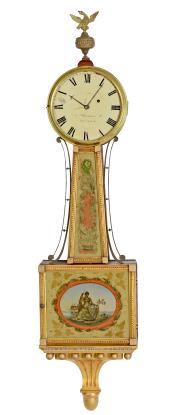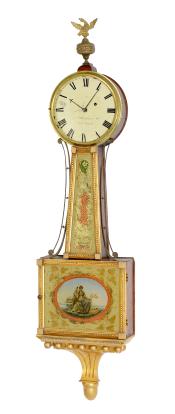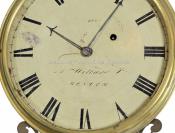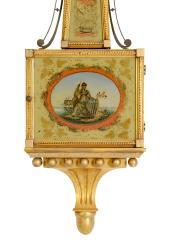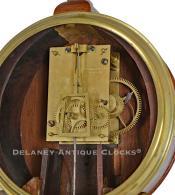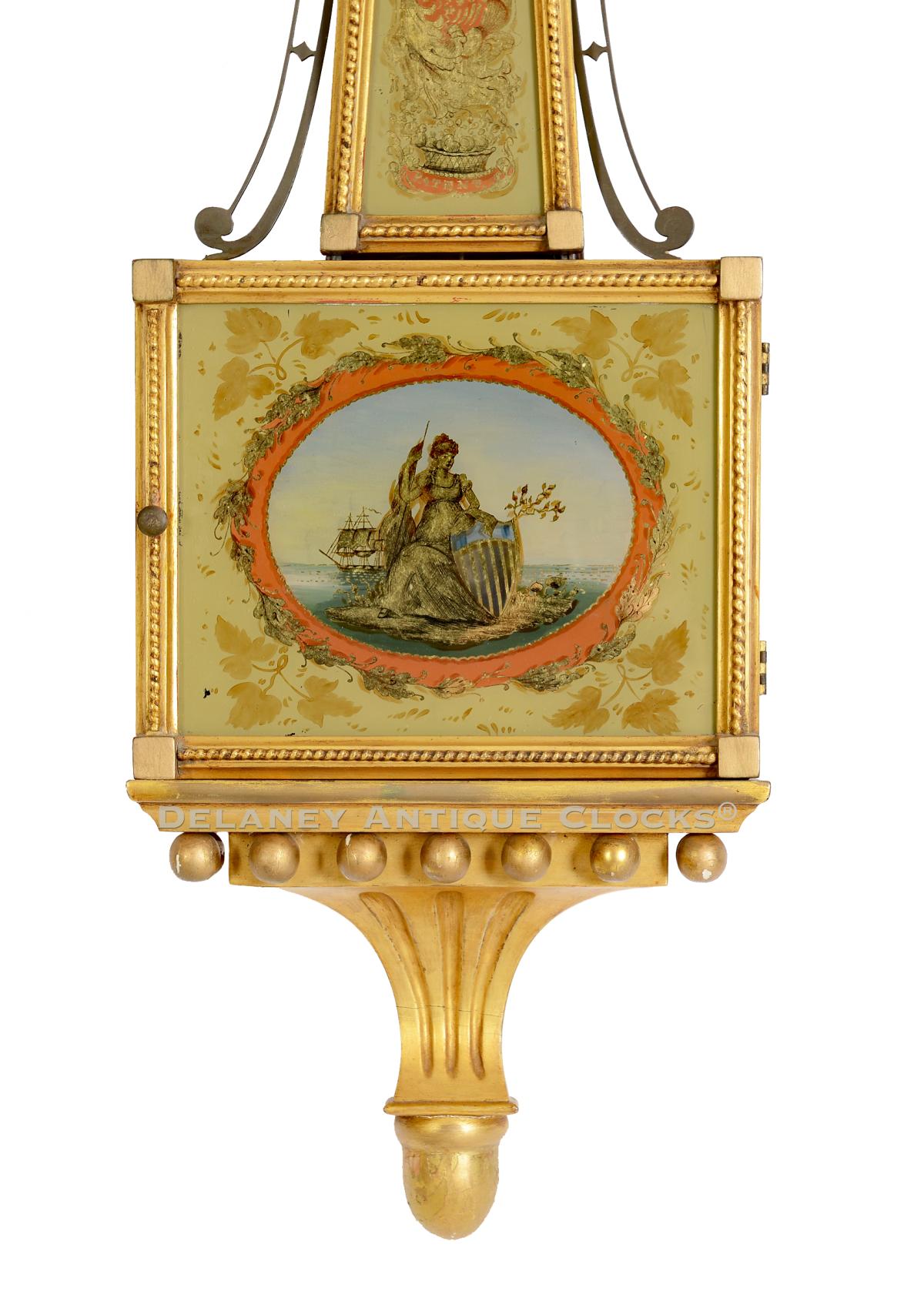An Aaron Willard Jr. gilt frame wall timepiece or banjo clock made in Boston circa 1815. This exquisite piece of history, with the lower tablet depicting “Columbia,” offers a unique connection to the past for antique enthusiasts. EEE-15.
This classic Federal Massachusetts Timepiece or “Banjo clock” was made by Aaron Willard Jr. of Boston, Massachusetts, circa 1815.
The case is constructed in mahogany and features rope-decorated frames finished in gilding. The re-gilded surfaces remain in excellent condition. This is a fancy example, having a presentation bracket with acorn finial and gilt decorative balls and an eagle-topped finial. Reverse-painted or eglomise tablets are secured in the frames. The subject and detail work exhibit a high level of skill. The lower tablet depicts an oval-shaped nautical scene featuring Columbia. The oval-shaped framing incorporates a line of gilt leaves, a reddish/orange banding, and a gilt ribbon. This detail is positioned over a brownish/yellow field decorated with maple leaves. Centered in the oval window is Columbia. She is an early female personification of the United States. She became the symbol of the new, independent country. She is poised, seated in a long gown. In her right hand, she holds the American flag and pole. In her left hand, she has an American shield. The shield stripes, an alternating pattern of gold and clear, allow one to see the motion of the brass-faced pendulum bob that swings behind the glass. Above the shield is an olive branch, signifying peace. Behind is a sailing vessel. The throat tablet has traditional timepiece themes, including a basket of fruit, florals, and stars. “PATENT” is also written in the banner. The patent pays homage to Simon Willard’s 1802 patent of this form. The colors used here complement those used in the lower tablet.
The sidearms, finial, and dial bezel are brass. The dial bezel is fitted with convex-shaped glass and opens to access the painted iron dial and the steel arrow-shaped hands.
The Maker’s name and working location are signed and are still legible after 200 years. The signature reads, “A. Willard, Jr. / BOSTON.” This dial is also numbered “No. 1785.” Roman-style hour numerals are used to demark the hours. The segmented minute ring includes dashes at each hour. Two elegantly hand-filed steel barbed hands show the time. A trait of most Aaron Willard Jr made wall clocks.
The time-only movement, a testament to the enduring quality of Aaron Willard Jr's craftsmanship, is weight-driven and designed to run for eight days on a full wind. Please note that the original lead time weight descends the channel in the center of the case directly below the works. The movement is mounted to the backboard with two thru-bolts that are diagonally positioned on the plates. They secure the backplate to the wooden backboard. Incredibly, the through bolts remain intact. It is more common that the wooden threads have weakened/failed due to repeated removal and installation. It is not uncommon for them to be replaced with wood screws. The movement features brass construction. Two brass plates frame the gearing and are secured by four brass pillars. The front plate is die stamped by the clockmaker, “A. WILLARD JR. / BOSTON.” Hardened steel shafts support the steel pinions and brass gearing. The pendulum is supported by a bridge suspension post. The pendulum is constructed with a steel rod and a brass-faced lead bob. The brass face is, of course, visible through the lower opening of the front door. This motion is a visual indication that the clock is operating. Overall, the movement is of excellent quality, which is typical of this Maker, providing a sense of assurance of the timepiece's reliability and durability.
This attractive clock measures approximately 43 inches long to the top of the finial. It was made circa 1815.
Inventory number EEE-15.
Aaron Willard Jr. was born in Roxbury, Massachusetts, on June 29, 1783. He had the good fortune of being born into America's leading clockmaking family. His father, Aaron, and uncle Simon had recently moved from the rural community of Grafton and began a productive career manufacturing high-quality clocks in this new ideal location. Based on the traditions of the day, it is thought that Aaron Jr. probably learned the skill of clockmaking from his family. We have owned a large number of wall timepieces or more commonly called banjo clocks, that this talented maker made. Based on the numbers seen in the marketplace, it is logical to assume he was one of the most prolific makers of this form. We have also owned a fair number of tall case clocks, Massachusetts shelf clocks, and gallery clocks. Aaron Jr. retired from clockmaking sometime around 1850 and moved to Newton, Massachusetts. He died on May 2, 1864

